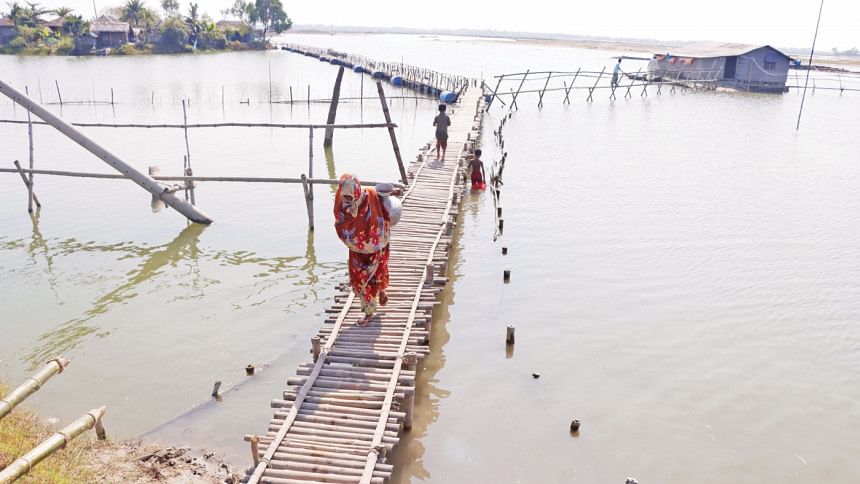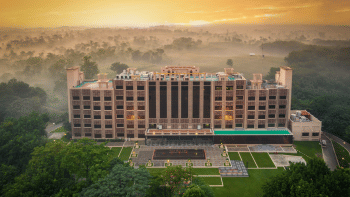Pratapnagar’s climate woes never end

Upon reaching the Harishkhali village in Pratapnagar union, an area on the forefront of climate impacts in the country,the first thing noticed was a red flag, hoisted by the launch terminal, fluttering against the southernbreeze.
It was around the middle of November.
After spotting some villagers nearby, this correspondent asked why the flag was there.
"It is a cautionary signal for another cyclone forming over the Bay," said an elderly man who introduced himself as Musa Sarder.
Due to the union's location, where it is surrounded by two rivers, effects of climate change, especially erosion, are frequently felt there. The vulnerability of the locals increase tenfold when there is a cyclone.
"Whenever there is a cyclone forecast, the union parishad office hoists this red flag and directs people to move to the shelters through loudspeakers."
Musa was speaking about the recent Cyclone Midhili, which at the time was just forming over the Bay.
When a cyclone hits the area, every single family living there is affected. So any cautionary signal causes panic among all, Musa continued.
"In 2007, Sidr hit and then Aila destroyed everything in 2009. In 2020, Amphan came and destroyed the embankments, eroded lands. I don't know what will happen this time [with Midhili]."
Adding to Musa, other villages said they are yet to recover from the damages caused by Amphan.
"The embankment was finally repaired last year. However, homes and lands had also been washed away and a large canal that runs through the whole village was created," Musa said.
He took this correspondent to Hawlader Para where the canal was created by Amphan's storm surge.
Stopping at the local union chairman's office, which fell on the way, The Daily Star spoke to union parishad Chairman Abu Daud Dhali
"Almost the whole union was submerged for over two years," he said.
According to union parishad data, there were 37,000 people living in 23 villages. Since Amphan, a few hundred families have left the union after their homes were washed away."
"After the embankment was breached, many people had to leave to different cities or relatives' homes further away from the union."
He added that the union, in Satkhira's Assasuni upazila, is surrounded by two rivers -- Shibsa and Kobadak -- and is protected by a circular embankment.
"You will notice there aren't any fully grown trees here. They have all been newly planted after the embankment was repaired. You will also see, there is no cattle grazing. You can guess how bad the damage was [from Amphan].
"Here, the constant challenge is to protect the embankment."
Though it was repaired just months ago, it is still vulnerable at some points.
"We have to keep a constant watch," the chairman said, adding they are trying to use the rain water to grow rice on the embankment.
"However, we are barring anyone from cultivating shrimp by bringing in saline water from the river."
Two years ago, he said, when saline water entered the the embankment, all the trees had died.
This time, with the repaired embankment, the locals made sure saline water was barred from seeping into it.
"But if anyone starts farming shrimp, this will happen again. Such farming only benefits a few individuals; it does not help the village or the union.
"But agriculture benefits whoever has a little piece of land. Through rice cultivation, not only can we protect the embankment but the people who are suffering from the effects of the cyclone can find a new livelihood."
Though the government made 21 cluster homes for landless people this year under the Ashrayan project, some families of Hawladar Para were living on the embankment as their homes were washed away by the cyclone, Dhali said.
Manik Hawladar, 65, was a successful farmer.
"But I was left penniless after Amphan hit our village in 2020. My house was made of concrete and the roof was made of asbestos cement sheets. I also had 565 feet deep tubewell … Everything was washed away overnight," he told this correspondent.
"The current was so strong that brick homes and a mosque were even washed away. The canal [created by the storm surge] passes through where my house used to be. It breaks my heart to see it.
"Though the government repaired the embankment ... I lost everything. I was never compensated for my losses," he said.
Manik had to take a loan to make a small wooden house but was afraid another cyclone would once again leave him homeless.
As he spoke, other villagers gathered.
They urged this correspondent to write down their names and the properties they lost.
Nurunnahar Begum requested repeatedly that her name be written down with the mention of her house on 16 decimals of land, which was washed away.
"I have to live in a hut by the embankment now. We got no relief from the government or any organisation."
She said this when Midhili was on its way. After it hit the country on November 17, that hut is also gone.
The union chairman said, "Though the damage by Midhili was less than that of Amphan, once again people were left homeless as all the makeshift shelters people made on the embankment were gone. They now have to look for new places and new homes once again."
He added that around 50-100 people are now suffering again, even before recovering from Amphan.
Contacted, Dr Ainun Nishat, professor emeritus who led the National Action Plan on climate change, said the sufferings of the people of Pratapnagar has been endless -- with no relief or compensation provided.
"Repairing the embankment is not enough. The government needs to initiate a proper post-disaster rehabilitation programme for these villagers."
While it is easier for the rich and the ultra-poor of the village to move to the cities, the middle-class has to stay back and face all the ordeals, he said.
"The rich can find shelter elsewhere while the poor can go to the cities and take up odd jobs or resort to begging. However, the middle-class is the one stuck with no alternative."
Prof Nishat further suggested the management of the embankment be handed over to the locals.
"Such kind of repair work, when done through the government offices, always goes through red tape before actual implementation. If the villagers are in charge of repairing it, they can do it faster as they know their own urgency and needs better."
(Our Khulna correspondent contributed to this report.)

 For all latest news, follow The Daily Star's Google News channel.
For all latest news, follow The Daily Star's Google News channel. 



Comments